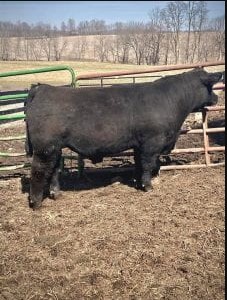By Stan Smith
Recently we visited in this publication about the value in having a bull that’s passed a breeding soundness exam (BSE) and is ready to go to work when called upon. One thing we’ve perhaps yet to discuss is what needs to happen after the bull has passed his BSE, or is purchased, and until he goes to the breeding pasture. While a bull might have been a “potentially satisfactory breeder” on the day of his BSE, it is important that the time that passes from then until the day he must go to work are spent in a way that allows him to remain sound while also transitioning to the pasture he’ll be working.

Bulls need to be transitioned from their winter diet to grass carefully before turn out.
For those of you who this season will be using young bulls, or even mature bulls that maybe have yet to be properly transitioned from winter ‘storage,’ OSU Extension Beef Specialist Dr. Stephen Boyles offers the following suggestions from his publication “Bull Nutrition and Management” regarding the pre-breeding season management of yearling bulls.
Post-purchase Management of Yearling Bulls: The yearling bull deserves some special attention as he begins his breeding career in order to assure that he will settle as many females as promptly as possible during his first working summer. You probably should not immediately turn him out with the cows.
Exercise and Facilities: The ideal condition for the young bull at the start of the breeding season is thrifty but not fat, hard and trim but not thin. He should be like a football player in mid-season. Bulls that are physically fit when they are turned out will breed more cows because they will retain a higher level of libido longer. Exercise prior to the breeding season will also reduce injuries from fighting and riding during the breeding season.
Young bulls can be very active and will exercise themselves if the bull pasture is of adequate area (about 2 acres/bull). Long, narrow paddocks may also be used. It is a good idea to locate supplemental feeding areas and water sources as far as possible apart to further encourage walking activity. The pasture or paddock should be a natural surface. The worst surface is a mud-and-manure lot outside the barn, with its many possibilities for hoof injuries. It is important to have a well-drained surface to get young bull’s hooves hardened and accustomed to walking.
Nutrition: Bulls are a troublesome group of cattle to provide proper nutrition. They are a relatively small group but can take up a lot of space. The tendency is to run all bulls together and hope that they won’t do much damage to the facilities or each other. But, nutritional needs vary due to age and condition, so if young and old bulls are run together some bulls may not get the nutrition they need and others may get too much.
Yearling bulls on performance tests have usually been on high energy diets. These bull need to be “let down” from the time they are purchased until they are turned out with cows. A mistake made occasionally is to turn the bulls that have been on a high grain ration out on very lush pasture or place them on straight high-quality alfalfa hay. This can lead to digestive upsets or imbalances, thus leading to potential reproductive problems. Research shows that is takes 60 days for sperm development.
The gain for yearling bulls prior to the breeding season should be about 2 pounds per day. This would require a diet containing 10-11% protein and 60-70% TDN (dry matter basis) which could be supplied by 6-10 lbs. of grain per day and full feed of medium quality hay. Any hay fed should be free from molds and green in color, if possible. No ergot can be tolerated at this time, so inspect any grain screenings closely before feeding (look for dark purple to black spots).
A mineral and vitamin mix should be offered that contains adequate calcium, phosphorus, and vitamin A. A standard mineral mix would be 40% dicalcium phosphate, 20% limestone, 30% trace mineral salt, and 10% selenium 90 (mg/lb) premix. Quality green forages should provide enough vitamin A. If forages are weathered and/or of low quality, an intramuscular injection of 3 million IU of vitamin A is advisable. A vitamin A injection might also be considered with corn silage-based diets.
Pasture: The young bull should be acclimated to grazing pasture for 7-10 days prior to the date he will be turned onto pasture with his cows, if possible. Several days are required for the rumen microflora to fully adjust from harvested feeds to fresh spring grass. This transitional stress should be accomplished prior to turning him into the herd.
Source : osu.edu